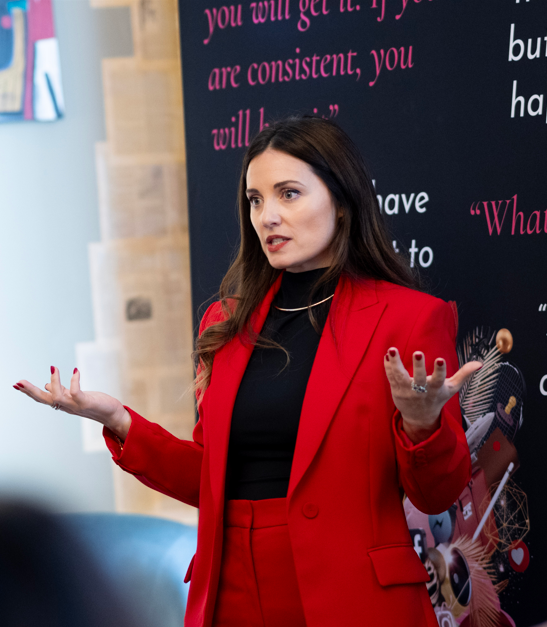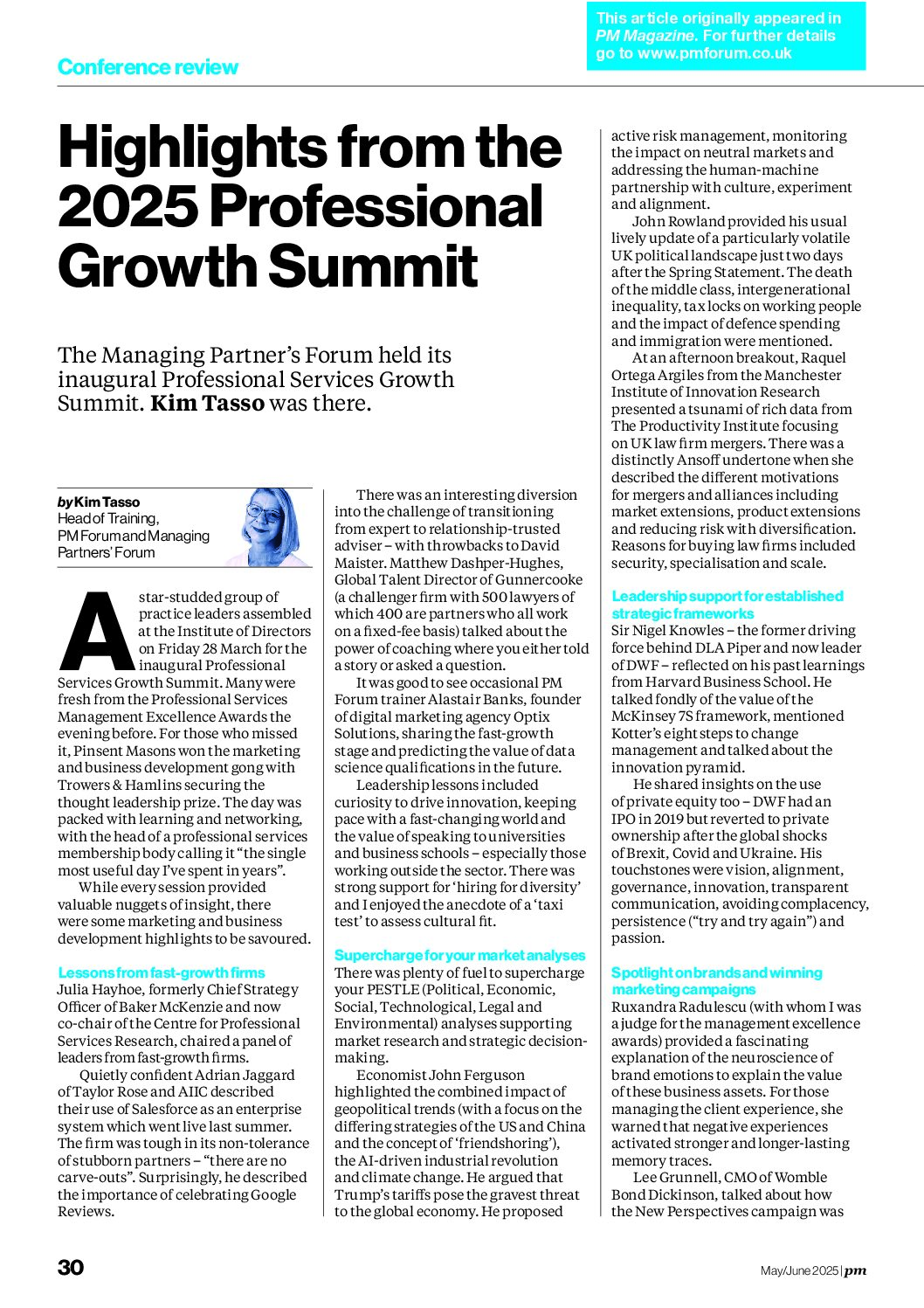The following article appeared in the 20th anniversary edition of Professional Marketing http://www.pmforum.co.uk/ – I’ve had so many comments about it, the lovely folk at PM said I could reproduce it here:
Kim Tasso, a veteran professional services marketer (since 1987), looks back over a quarter century of developments in our profession and postulates a brave new marketing world.
In 1993 (when pm started), I had completed seven years working inhouse at accountancy and law firms and had just set up my own business. That was some itch! They were, as they say, interesting times.
As the rules preventing solicitors from marketing had only been relaxed a few years before, there were just five people employed in senior marketing roles in law firms across the UK – and I knew them all. We met regularly for mutual support – usually with a few drinks to drown our numerous sorrows.
There were one or two interesting characters leading the way – I particularly remember lawyer-turned-Lord Digby Jones from Edge & Ellison solicitors in Birmingham. And a guy from senior management at the Post Office at nowabsorbed lawyers Turner Kenneth Brown. During my time in the accountancy sector, I clearly recall George Westropp – a former City reporter who had become the first non-accounting partner at a Big Four practice – who spent a lot of time managing the media for the massive BCCI insolvency case. There was also an advertising expert who designed – with one of the top agencies of the day – a groundbreaking national media campaign to differentiate his firm’s brand.
Richard Chaplin hosted the first editorial board meetings for pm at his house in London. The beginnings of the Managing Partners’ Forum and Professional Marketing Forum consisted of about 10 folk who met occasionally over supper at a City wine bar. How times have changed!
I admit I was a little irritated when recently an article in a legal magazine (written by people who I can assure you were not around in those early days) pretty much wrote off all early professional service marketers as being either administrative staff or poor calibre marketers. I’m surprised there weren’t defamation proceedings, but then true professionals rise above such ignorance and pettiness.
For sure, the lack of knowledge (and sometimes gumption) amongst partners in both accountancy and law firms did prevent many early marketers from performing a strategic marketing role. And for a long time, those in the real estate market confused property marketing with services marketing. But have no doubt that these marketers had a big impact. They were pioneers, driving a massive sector-wide change programme and creating the new discipline – through trial and error – of professional services marketing.
From back room marketing communications…
It is true that many early marketers were locked into promotional campaigns. Brochures were seen as a panacea and to get those early newsletters and invitations out (remember that this was pre-email) there were all sorts of diversions into design, printing, stuffing and, of course, databases.
When I first arrived at a law practice in 1989 I was their first marketer and shared an office with a senior corporate lawyer. They had been through several PR agencies (and a significant sum of cash) – unsuccessfully. The nature of the clientlawyer relationship, the sensitivity about professional rules governing client relationships and the complexities of dealing with partnerships were simply too much for them. But we marketers were working from the inside.
Whilst client entertaining with a sprinkling of networking was firmly established as the mainstay of business development, there were inroads made into other approaches – thus the first seminars and conferences. I remember boardroom tussles with the leading advertising agencies of the time as partners struggled to understand the difference between branding and logos. And had fits about the potential costs. And no idea about segmentation. Oh happy days!
To a more strategic role
Some leading FMCG marketers came into the professions in those early days. But most of them quickly grew frustrated at a lack of a cohesive ‘corporate’ strategy, a total fail at understanding what marketing could and should do, fragmentation amongst the partners and a solid wall of resistance to doing almost anything. Most of them quickly left to ply their professional skills in a more conducive environment.
There were folk, like myself, from the technology sector and others from financial services, the public sector, broadcasting and other diverse areas. About the only thing we had in common was a passion for marketing and an almost pig-headed determination to drag the professions kicking and screaming into the 21st century.
The state of the profession
We’ve come a very long way. Although often it doesn’t feel like it as the same old arguments replay time and again when marketer meets fee-earner. But there are numerous examples of super-profits and amazing change and growth amongst the firms, where the success must be at least partly attributed to inspired and sustained marketing.
There’s currently a polarisation in professional service marketing. The big firms are sophisticated in their marketing programmes with large teams of specialists and deep pockets to finance systems. The medium and smaller firms tend to rely on one or two strategic folk and/or a small team of assistants who manage the day to day operational aspects of communications.
The Internet has had a profound effect on everyone and those involved in B2C services have invested heavily in PPC and SEO. Meanwhile, those in B2B grapple with the threats and opportunities of social media while concentrating their efforts in structured selling programmes. A few of the newer entrants are throwing their weight around with branding and television/ national press advertisements similar to those we witnessed way back at the outset.
To infinity and beyond?
And what about the future? There are a few trends I have noticed.
Large firms trust only their own – The larger firms are trading in their pure-play professional marketers for qualified lawyers, accountants or surveyors. These folk may or may not have been fasttracked through the business development learning curve. A rare few take the time to qualify in marketing. They have what few marketers possess, a deep insight into the technical product and the ability to form meaningful relationships with in-house counsel, finance directors and property investors. The technical clients. Where serious relationship management (whether direct selling or account management) dominates, you can see the sense in this approach.
Extreme specialising – The large firms also have the scale to be able to recruit specialists and allow them to develop their areas to a very sophisticated level. Look at the social media and community managers who manage a whirlwind of brand communications and sales interactions across multiple online platforms and who use analytics systems in a scientific way to drive success. One hopes that they won’t be so specialist that yet another marketing-fee-earner communication cavern opens up. Or consider those who dedicate their lives to improving pitch performance – just how long can those people work under such insane pressure? And the digital marketers – who know as much about databases, encryption and ‘big data’ as their colleagues in IT – are taking over from the generalists.
Marketing technologists – This is a natural progression from the ‘extreme specialising’ trend. Whilst one element of professional service marketers hone their people skills – through coaching, selling, client service and relationship management initiatives – another element gets more intimate with technology. The marketing geeks know how to find, calculate, research and communicate anything and anyone by a few clicks on either public networks or proprietary systems. They may not be able to converse with mere mortals, but their command of data has them revered and feared.
Strategic team leaders – Those in medium sized firms who have had success developing new markets and services, generating new revenue and profit streams and promoting real cultural change within their firms have been promoted. They sit on their firm’s boards and play a pivotal leadership role in the flurry of other change programmes that have now come to the fore. Some are elevated to CEO and COO roles and others have had talent or knowledge management added to their brief. Others are the right-hand-man (or woman) for their managing partners or managing directors. Change is the name of their game. And they do it organisationally.
4Ps revisited: Pricing, Product, Project and Procurement Management – For the rough roads ahead for the professions, I see some new skill sets coming to the fore as marketers are finally allowed to practice their craft in some previously no-fly zones. I think of it fondly as a new set of 4Ps. They emerge as a result of continued downward fee pressure and a serious lack of original thought in the development of differentiated value propositions. Pricing spans economics, marketing, psychology and more. Product/service development needs a double whammy of technical expertise and client intimacy. Project management on a grand scale requires breadth of knowledge as well as an armoury of specialist skills. And being conversant with the latest practices in procurement requires real dedication. And the patience of a saint. My concern is that if marketers aren’t quick enough – the vacuum will be filled by those in the financial, knowledge management and operations teams.
All change
Heralitus said: “The only thing that is constant is change”. I would argue that this constant change is what drives the exemplars of professional services marketing. They would get bored dealing with the same old challenges, in the same old ways all the time. My prediction is that while many will survive this quagmire we call professional services, those who thrive are the committed chameleons. Ever alert to a new challenge or trend. First in line to pick up the often poisoned chalice. Determined to win over the nay-sayers and show that profits can still be made in a myriad of ways.









